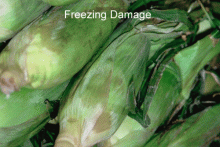Product Description
Maturity and Quality
Sweet corn is considered mature for fresh market consumption or "baby kernel" processing when the pollination silks are dried and the kernels are still immature. The husk leaves remain tight and have a good green appearance. The ear is firm and turgid. The kernels are plump and appear 'milky', and not doughy, when squeezed. At this point the kernels of standard 'sugary' corn are 70-75% water content and kernels of sh-2 corn are at 77-78% water content.
Quality of fresh market sweet corn is judged by its fresh, uniform appearance, uniform and well filled rows, plumpness of kernels, milky kernel contents, and freedom from damage and defects (discoloration, harvest injury, worm damage, live insects, decaying silks or kernels). Trimmed, husked, or minimally processed whole-ears (i.e. microwave consumer packs) have additional grade standards for husk cover, husk appearance, length, and other quality indicators.
U.S. Grades are Fancy, Fancy-Husked, No. 1, No. 1-Husked, and No. 2 (effective Feb. 12, 1992)
Postharvest Handling and Storage
0°C-1.5°C (32°F-34°F)
Typically iced. Standard sweet corn is not stored for more than a few days due to the rapid deterioration of quality, even at ideal temperatures. When short-term storage is necessary for orderly marketing, the maximum duration including transit times should not exceed 7 days. Super sweet corn has been stored at 0°C for up to 21 days with generally acceptable market quality.
| Temperature °C (°F) |
ml CO2/kg·hr |
| 0 (32) | 30-51 |
| 5 (41) | 43-83 |
| 10 (50) | 104-120 |
| 15 (59) | 151-175 |
| 20 (68) | 268-311 |
| 25 (77) | 282-435 |
To calculate heat production multiply ml CO2/kg·hr by 440 to get Btu/ton/day or by 122 to get kcal/metric ton/day.
Exogenous ethylene is not considered an important postharvest handling factor.
95-98%
Cooling and Top Icing
Rapid removal of field heat and continuous and proper refrigeration are essential to the maintenance of sweet corn quality. Sweet corn is generally hydrocooled and packed with ice and/or top-iced. After thorough cooling and icing, storage and transit temperatures are held slightly above 0°C (32°F) to prevent freezing of the ice layer and "capping-off" of the container, which could reduce proper air circulation. Handling in bulk containers should be avoided unless provisions for generous and uniform icing can be assured.
Controlled or modified atmosphere storage or shipping offer moderate benefits to sweet corn quality maintenance. Low O2 levels (3%) and elevated CO2 (10%) delay loss of sucrose content and maintain appearance of husks. CA at 5°C (41°F) is superior to storage in air alone, but sugar content is not retain-ed as well as corn stored at 0°C (32°F). Sweet corn does not tolerate low 2 (<2%) or elevated CO2 (greater than or equal to 20%).
Disorders
Freezing Injury. Freezing injury will be initiated at -0.6°C (31°F). Symptoms of freezing injury include watersoaked patches on the husks and watersoaked kernels becoming gelatinous and developing off-odors over time.
Fresh market harvesting should be done by hand. Ears are snapped downward and away from the main stalk. Stalk ends are trimmed short to prevent excessive moisture loss.
Diseases are not an important source of postharvest loss as compared to field acquired insect damage and physiological deterioration due to the high rate of respiration and conversion of sugars to starch. Dry silks often develop superficial molds after longer storage (greater than 10 days).
Special Considerations
Minimally processed frozen sweet corn may have better quality when the super sweet (sh-2) genotype is used rather than the typical sweet (su) genotype. Blanching prior to freezing is a common commercial and home consumer practice that may be minimized for super sweet varieties due to lower activity of enzymes which cause flavor changes. UC Davis research has shown that super sweet varieties typically require a 4 min blanch while sweet corn varieties require 6 or more minutes for corn-on-the-cob. Research done by both the USDA and UC Davis shows that during frozen storage of super sweet corn, sucrose increased and reducing sugars decreased in unblanched super sweet corn. After frozen storage for 8-9 months, sensory panels preferred blanched rather than unblanched super sweet corn.




